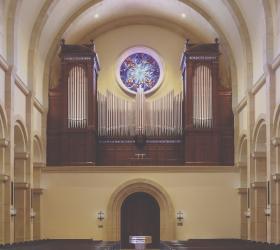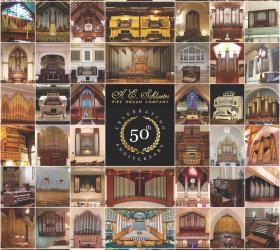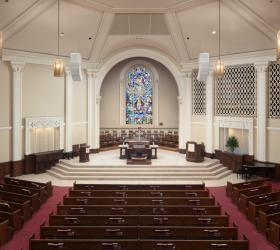
Cover
Quimby Pipe Organs, Inc.,
Warrensburg, Missouri
Robert E. Jacoby Symphony Hall, The Time-Union Center for
the Performing Arts, Jacksonville, Florida
Quimby Pipe Organs, Inc., Warrensburg, Missouri, recently
completed the rebuilding and installation of the 1912 Casavant organ in the
Robert E. Jacoby Symphony Hall, Jacksonville, Florida.
style="mso-spacerun: yes"> This project marked the formal
completion of the 1,846-seat performance facility dedicated to the Jacksonville
Symphony, and reflects the Symphony's decision to become the first
American orchestra to install a rebuilt, historic organ in a new concert hall.
Casavant Op. 553 was contracted in 1912 and built in 1914
with four manuals, 63 stops, 70 ranks for the First Baptist Church of Syracuse,
New York. The organ gained some international notoriety when Charles Courboin,
famous Belgian organist of the Cathedral in Antwerp, immigrated to the United
States in 1904 and became organist of the church in 1915.
The organ was first enlarged in 1917, under the direction of
Courboin, with the addition of a second Solo division consisting of six
high-pressure stops, provided by Casavant's American factory in South
Haven, Michigan. In 1957, Casavant furnished a new, four-manual drawknob
console and, in 1973, new Great Twelfth, Fifteenth and Mixture and Pedal
upperwork were provided under the direction of Lawrence Phelps. In the late
1980s, when the congregation moved to a new building in the suburbs, the organ
was put into circuitous storage that took it from New York to Illinois to Florida
and finally back again to Illinois.
In early 1996, the Jacksonville Symphony began its search
for an organ. After much research and with the assistance of consultant Jeff
Weiler, the Symphony decided that an older instrument, built during the height
of organ-orchestral repertoire, would be ideal for the orchestra's needs.
Casavant Op. 553 was located in Chicago, languishing in a warehouse, and was
purchased by the symphony later in 1996.
The organ was delivered to Quimby Pipe Organs in
Warrensburg, Missouri, for rebuilding and restoration in March, 1997. An
inventory revealed that storage had taken its toll on the organ:
style="mso-spacerun: yes"> most of the Casavant windchests were
discovered to be beyond repair, either through dry rot or water damage; many
metal pipes were severely damaged and numerous pipes were smashed flat; wooden
pipes were found to have split seams, either through water damage or extreme
dryness. What was expected to have been a fairly typical rebuilding was fast
turning into a massive restoration.
All flue pipework was restored in our pipeshop by
Christopher Emerson, QPO pipemaker, with extensive help by Thomas Anderson.
Dents were re-moved, smashed pipes were cut apart and remade, and all metal
pipes were cleaned and fitted with new tuning slides. All stopped wood pipes
were repacked, and split seams reglued as necessary.
One significant challenge involved maintaining the tonal
integrity of the reed ranks while raising their pitch to A440. Head voicer Eric
Johnson performed restorative revoicing to repitch the reeds, utilizing the
original tongues as much as possible. The rise in pitch increased the overall
power of the reeds significantly.
The Great/Choir 16'-8'-4' Tuba Mirabilis unit, recast
on 25" to meet the requirements of the hall, provides a thrilling climax
to the organ.
The Casavant winding system was recreated with great care,
and can only be described as massive.
The Swell reservoir, for example, measuring 5'x11', bears
1200 pounds of brick and 2,000 pounds of spring tension to provide 41/2"
pressure; the Solo reservoir, feeding 12" of wind to that division, bears
2200 pounds of brick and 3000 pounds of spring tension!
style="mso-spacerun: yes"> The organ's original 1914 10 hp
Spencer blower, providing static pressure at 5" and 12", and the
1917 71/2 hp Spencer blower for the added Solo organ, providing 25"
of static pressure, were both rebuilt by Eric Johnson.
style="mso-spacerun: yes"> The blower room is isolated beneath the
Solo division by walls nearly 18" thick.
The organ stands in a loft 50' wide, 32' high
and 14' deep above and behind the orchestra platform.
style="mso-spacerun: yes"> Composed of painted copper pipes of the
Great First and Second Diapasons, the Pedal 8' Octave, and the Great 16'
Double Diapason, the tripartite façade, designed by Charles Ford,
provides the visual focus for the room. The Great and Pedal occupy the central
section with the commanding (formerly enclosed) Tuba Mirabilis placed high at
the center of the organ. The Solo is housed the left section, and Choir is
placed above the Swell in the right section. The Echo occupies a chamber 70'
above the floor in the ceiling of the auditorium, providing an ideal location
for its subtle, atmospheric effects. As in the original Syracuse installation,
the Echo is winded from the main blowing plant.
A few voices have been added to the organ in its present
installation. Mixtures and
mutations have been added to enhance the Swell and Choir choruses; two celestes
have been added to the organ's softest existing voices; existing tenor C
celestes have been extended to CC, and a 4' Clarion now completes the
Swell reed chorus. The Choir Mustel Celesta was re-pitched to A440. The two
Solo divisions (from 1914 and 1917) have been united as one. The 1957 console
has been rebuilt utilizing solid-state actions. Apart from the windchests for
the Echo, the Solo Gross Flute and Tuba Mirabilis unit chests (made in the
South Haven, Michigan plant), various bass offset chests and the 1973 Casavant
pedal chest, all pipework sits on new electropneumatic pitman windchests.
style="mso-spacerun: yes"> The organ now contains 97 ranks, 80
stops, 6,215 pipes and weighs nearly 20 tons.
The organ was
officially opened during a gala weekend, March 16-18, 2001, by the
Jacksonville Symphony, Fabio Mechetti, conductor, and Matt Curlee, organist,
performing works by Saint-Saëns, Duruflé and Jongen. As part of the
weekend's festivities, the organ was donated to the City of Jacksonville
in exchange for the city's generous support of the rebuilding effort and
financial commitment to its ongoing care. The Jacksonville Symphony, the latest
American orchestra to include a major pipe organ among its musical resources,
will feature the organ in major works five times next season. For more
information, consult the Jacksonville Symphony's Web site:
<www.jaxsymphony.org/organ.htm>.
--Thomas Brown
General Manager, QPO
Photo by Paul Figura, art direction by Kevin Eitzenberger.
GREAT (unenclosed)
33/4" windpressure
16'
Double
Open Diapason (1-19 façade,
new)
16'
style='mso-tab-count:1'> Gemshorn
(ext)**
8'
style='mso-tab-count:1'> Open
Diapason I (1-12 façade, new)
8'
style='mso-tab-count:1'> Open
Diapason II (1-10 façade, new)
8'
style='mso-tab-count:1'> Geigen
Principal
8'
style='mso-tab-count:1'> Flûte
harmonique
8' style='mso-tab-count:1'> Doppelflöte style='mso-tab-count:2'> style="mso-spacerun: yes">
8' style='mso-tab-count:1'> Gemshorn
4' style='mso-tab-count:1'> Octave
4' style='mso-tab-count:1'> Principal
4' style='mso-tab-count:1'> Waldflöte
22/3' style='mso-tab-count:1'> Twelfth **(*)
2'
style='mso-tab-count:1'> Fifteenth
**(*)
Mixture
V **(*)
16'
style='mso-tab-count:1'> Double
Trumpet
8' style='mso-tab-count:1'> Trumpet
16'
style='mso-tab-count:1'> Tuba
Magna (Ch)
8'
style="mso-spacerun: yes"> Tuba
Mirabilis (Ch)
4'
style='mso-tab-count:1'> Tuba
Clarion (Ch)
Chimes
(Echo)
SWELL (enclosed)
41/2" windpressure
16' style='mso-tab-count:1'> Bourdon
8'
style='mso-tab-count:1'> Open
Diapason
8'
style='mso-tab-count:1'> Viola
da Gamba
8'
style='mso-tab-count:1'> Voix
céleste
8' style='mso-tab-count:1'> Clarabella
8'
style='mso-tab-count:1'> Stopped
Flute
8' style='mso-tab-count:1'> Dolcissimo
8'
style='mso-tab-count:1'> Dolce
Celeste ***
4' style='mso-tab-count:1'> Fugara
4'
style='mso-tab-count:1'> Flauto
Traverso
2' style='mso-tab-count:1'> Piccolo
Cornet
IV
Plein
Jeu III-V ***
16' style='mso-tab-count:1'> Bassoon
8' style='mso-tab-count:1'> Cornopean
8' style='mso-tab-count:1'> Oboe
8'
style='mso-tab-count:1'> Vox
Humana
4'
style='mso-tab-count:1'> Clarion
***
Tremulant
Vox
Tremulant
CHOIR (enclosed)
31/4" windpressure
16'
style='mso-tab-count:1'> Contra
Gamba
8'
style='mso-tab-count:1'> Open
Diapason
8' style='mso-tab-count:1'> Melodia
8'
style='mso-tab-count:1'> Lieblich
Gedeckt
8' style='mso-tab-count:1'> Dulciana
8'
style='mso-tab-count:1'> Unda
Maris ***
4' style='mso-tab-count:1'> Violina
4'
style='mso-tab-count:1'> Suabe
Flute
22/3' style='mso-tab-count:1'> Nazard ***
2' style='mso-tab-count:1'> Flageolet
2'
style='mso-tab-count:1'> Flute
***
13/5' style='mso-tab-count:1'> Tierce ***
Mixture
III-IV ***
16'
style='mso-tab-count:1'> Contra
Fagotto
8' style='mso-tab-count:1'> Clarinet
Tremulant
Celesta
(Mustel, 49 bars)
16'
style='mso-tab-count:1'> Tuba
Magna (ext., 12 pipes)
8'
style='mso-tab-count:1'> Tuba
Mirabilis (unenclosed) *
4'
style='mso-tab-count:1'> Tuba
Clarion (ext., 12 pipes)
M. L. Bigelow & Co., of American Fork, Utah, has
recently completed a new tracker action organ, opus 24, for Conception Abbey,
Conception, Missouri. The three-manual, 40-rank organ features a detached,
reversed key desk with mechanical key action, and electric stop/combination
action with 32 levels of memory. The instrument is located in the south
transept with both organ and organist facing the monk choir seated in the
crossing. To improve the feel of coupled manuals, the mechanical couplers are
housed in the lower case rather than the detached key desk. Manual key compass
is C1-a58; keys are of bone and ebony. The interchangeable AGO and flat
pedalboards each have 30 notes, C1-f30. Temperament is Fisk I, which
gives a slight variety of key colors, the key of F being the most solid
sounding. Metal pipes are of various alloys ranging from hammered lead for the
Chimney Flute 8', to 75% tin for the façade. Many larger pipes are
of copper. Wind pressure is 74 mm and is regulated by three wedge bellows
supplying the manual divisions, the pedal chest, and the bottom octave of the
32' respectively. The organist can deactivate wind stabilizers from the
key desk to achieve flexible winding. The organ was installed as part of a
massive renovation of the church in which the wood floor was removed and
replaced with concrete overlaid with brick pavers. Reverberation exceeds five
seconds. The first inaugural recital was played on December 5, 1999, by Delores
Bruch, who also served as consultant. The second inaugural recital was played by John Obetz on February 17,
2000.
GREAT
16' style='mso-tab-count:1'> Praestant
8' style='mso-tab-count:1'> Principal
8'
style='mso-tab-count:1'> Spire
Flute
4' style='mso-tab-count:1'> Octave
22/3' style='mso-tab-count:1'> Quint
2'
style='mso-tab-count:1'> Super
Octave
IV style='mso-tab-count:1'> Mixture
8' style='mso-tab-count:1'> Trumpet
Ch/Gt
Sw/Gt
CHOIR
8'
style='mso-tab-count:1'> Oak
Gedackt
8' style='mso-tab-count:1'> Gemshorn
8'
style='mso-tab-count:1'> Unda
Maris
4' style='mso-tab-count:1'> Viol-Principal
4'
style='mso-tab-count:1'> Flute
d'Amour
2' style='mso-tab-count:1'> Flageolet
11/3' style='mso-tab-count:1'> Larigot
8' style='mso-tab-count:1'> Krummhorn
Tremulant
Sw/Ch
SWELL
16' style='mso-tab-count:1'> Gedackt
8'
style='mso-tab-count:1'> Open
Diapason
8'
style='mso-tab-count:1'> Chimney
Flute
8'
style='mso-tab-count:1'> Viola
da Gamba
8'
style='mso-tab-count:1'> Voix
Celeste
4' style='mso-tab-count:1'> Principal
4'
style='mso-tab-count:1'> Harmonic
Flute
22/3' style='mso-tab-count:1'> Nazard
2' style='mso-tab-count:1'> Octave
13/5' style='mso-tab-count:1'> Tierce
III
style='mso-tab-count:1'> Plein
Jeu
16' style='mso-tab-count:1'> Basson
8' style='mso-tab-count:1'> Trompette
8' style='mso-tab-count:1'> Hautbois
Tremulant
PEDAL
32'
style='mso-tab-count:1'> Subbass
(ext)
16'
style='mso-tab-count:1'> Praestant
(Gt)
16' style='mso-tab-count:1'> Subbass
16'
style='mso-tab-count:1'> Gedackt
(Sw)
8'
style='mso-tab-count:1'> Praestant
(Gt)
8'
style='mso-tab-count:1'> Flute
Bass (ext)
II
style='mso-tab-count:1'> Octaves
(4'+ 2')
16' style='mso-tab-count:1'> Trombone
16'
style='mso-tab-count:1'> Basson
(Sw)
8'
style='mso-tab-count:1'> Trumpet
(Gt)
Gt/Ped
Ch/Ped
Sw/Ped
Steinberg Organ Co., Inc., Niagara Falls, Ontario, Canada,
has recently installed a 7-rank unit organ, their Opus 14, in the chapel of the
Redemptoristine Nuns at their Monastery of the Most Holy Redeemer in Niagara
Falls, Ontario. Since space was at a premium in the chapel, which was not
designed to house a pipe organ, a place was found on the right side of the
altar in an open area on the second level. The sisters use the organ for their
daily devotions, as well as for Sunday masses which are open to the public.
Sister Mary Alphonse is the organist. The pipework, chests, reservoir and
chimes are from a 1930 Franklin Legge organ which was removed from the First
Baptist Church in Welland, Ontario. A new organ front and case were built,
containing pipes from the 8' Open Diapason; casework is oak with a
rosewood finish. All pipes were revoiced and chests were rebuit.
GREAT
8'
style='mso-tab-count:1'> Open
Diapason
8'
style='mso-tab-count:1'> St.
Diapason
8' style='mso-tab-count:1'> Dulciana
4' style='mso-tab-count:1'> Octave
4'
style='mso-tab-count:1'> Lb.
Flute
2' style='mso-tab-count:1'> Fifteenth
SWELL
16'
style='mso-tab-count:1'> Violone
(TC)
8' style='mso-tab-count:1'> Gedeckt
8' style='mso-tab-count:1'> Salicional
8'
style='mso-tab-count:1'> Voix
Cel
4' style='mso-tab-count:1'> Flute
4' style='mso-tab-count:1'> Salicet
22/3' style='mso-tab-count:1'> Nasard
2' style='mso-tab-count:1'> Piccolo
8' style='mso-tab-count:1'> Oboe
Chimes
PEDAL
16' style='mso-tab-count:1'> Bourdon
8' style='mso-tab-count:1'> Diapason
8' style='mso-tab-count:1'> Bourdon
8' style='mso-tab-count:1'> Violone
4' style='mso-tab-count:1'> Octave




